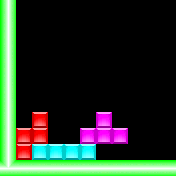Infinity: Difference between revisions
*>Tepples move "I'm ridin' spinnaz" link from SRS |
No edit summary |
||
| (28 intermediate revisions by 15 users not shown) | |||
| Line 1: | Line 1: | ||
[[Image:Tetris-spinnaz.gif|thumb|This T tetromino rotates infinitely as long as the player does not wait half a second between moves.]] | |||
'''Infinity''' is [[The Tetris Company]]'s term{{citation needed}} to refer to a characteristic in some [[Tetris Guideline]]-compliant games where the [[lock delay]] of a tetromino is reset whenever it is moved or rotated (even O, which ordinarily does not rotate). | |||
The term Infinity (Japanese:インフィニティ) has been seen mostly in the official documentation of Japanese games, and used by developers. In [[Tetris Worlds]], where the feature first appeared, the feature was called ''Easy Spin'' within the game. The feature can also be referred to as ''move reset'' in contrast to the ''step reset'' behavior of lock delay in the [[TGM series]], although the term "move" in particular may connote shifts more than rotations. It can also be seen referred to by some players (often ones unaware of the guidelines) as ''infinite spin''. | |||
This controversial feature allows a single tetromino to be easily kept "alive" forever. To reduce the negative effects of this, newer Tetris games tend to have modes that reward play speed, such as points per minute or garbage per minute. Also, while the number of times the player can move or rotate a piece is usually unlimited, limits can be instated in certain situations such as versus play in [[Tetris DS]], or arcade situations like [[TGM3]], where infinite prolonging of play is undesirable. In situations where such limits are in effect, the tetromino automatically locks down after the player resets the lock delay through movement or rotation, for a set number of times or seconds. Most games since 2007 have a limit of 15 move resets before the piece locks. | |||
== | The feature usually appears alongside [[SRS|Super Rotation System]]. However, in a few console games such as [[Tetris Advance]], [[Tetris: New Century]] and the GameCube and Xbox versions of Tetris Worlds, the feature can be turned off. Turning Infinity off in Tetris: New Century will revert the game to a ''step reset'' lock delay behavior. The feature can also be applied to other rotation systems as well, for instance in [[Tetris The Grand Master Ace]] it can be seen applied to the [[TGM rotation]] system. | ||
== Criticism == | |||
Ryan Davis of ''GameSpot'' wrote in his review of ''Tetris Worlds'' that infinity "actually breaks Tetris".<ref>http://www.gamespot.com/gba/puzzle/tetrisworlds/review.html?mode=gsreview</ref> | |||
Mike Nowak of ''the-inbetween.com'' wrote the same thing about ''Tetris DS''.<ref>http://the-inbetween.com/archives/000502.php</ref> | |||
== References == | |||
<references /> | |||
== See also == | |||
* [[Guideline compliant game differences]] | |||
[[Category:Gameplay]] | |||
Latest revision as of 14:42, 17 November 2019

Infinity is The Tetris Company's term[citation needed] to refer to a characteristic in some Tetris Guideline-compliant games where the lock delay of a tetromino is reset whenever it is moved or rotated (even O, which ordinarily does not rotate).
The term Infinity (Japanese:インフィニティ) has been seen mostly in the official documentation of Japanese games, and used by developers. In Tetris Worlds, where the feature first appeared, the feature was called Easy Spin within the game. The feature can also be referred to as move reset in contrast to the step reset behavior of lock delay in the TGM series, although the term "move" in particular may connote shifts more than rotations. It can also be seen referred to by some players (often ones unaware of the guidelines) as infinite spin.
This controversial feature allows a single tetromino to be easily kept "alive" forever. To reduce the negative effects of this, newer Tetris games tend to have modes that reward play speed, such as points per minute or garbage per minute. Also, while the number of times the player can move or rotate a piece is usually unlimited, limits can be instated in certain situations such as versus play in Tetris DS, or arcade situations like TGM3, where infinite prolonging of play is undesirable. In situations where such limits are in effect, the tetromino automatically locks down after the player resets the lock delay through movement or rotation, for a set number of times or seconds. Most games since 2007 have a limit of 15 move resets before the piece locks.
The feature usually appears alongside Super Rotation System. However, in a few console games such as Tetris Advance, Tetris: New Century and the GameCube and Xbox versions of Tetris Worlds, the feature can be turned off. Turning Infinity off in Tetris: New Century will revert the game to a step reset lock delay behavior. The feature can also be applied to other rotation systems as well, for instance in Tetris The Grand Master Ace it can be seen applied to the TGM rotation system.
Criticism
Ryan Davis of GameSpot wrote in his review of Tetris Worlds that infinity "actually breaks Tetris".[1] Mike Nowak of the-inbetween.com wrote the same thing about Tetris DS.[2]